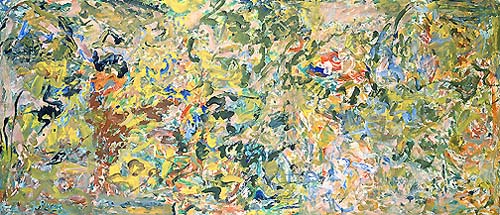Milton Resnick - John Laughlin
dal 3/4/2002 al 4/5/2002
Segnalato da
3/4/2002
Milton Resnick - John Laughlin
Robert Miller Gallery, New York
Milton Resnick's early paintings are a challenge to our understanding of the development of American abstraction.An exhibition of paintings from the 1950s and 1960s. Photographer, writer, architectural historian, bibliophile, poet of the imagination: Clarence John Laughlin (1905-1985) exhibition of photographs.

The Robert Miller Gallery is pleased to
present an exhibition of paintings from the
1950s and 1960s by Milton Resnick. The
exhibition will open with a reception on
April 4, from 6 to 8 pm.
Milton Resnick's early paintings are a
challenge to our understanding of the
development of American abstraction.
Instead of arriving at abstraction through
a logical series of experiments like many
of his generation, Resnick made a more
emotional "leap of faith" and ignored
intellectual justification. In the late 1950s
Resnick began to diverge from the
reigning style of Abstract Expressionism
toward a style characterized by gesture of
a smaller scale. This reduced scale lent
itself to an overall composition in which
color and the effect of a "field" played a
greater role than drawing as the dominant
expressive element. Resnick was striving
to make paintings which had no specific
focus, where one part of the canvas was
not more important than another. He
eliminated line altogether, replacing it with
an increased painterliness, and eschewed
color theory for a direct confrontation
with paint. With line no longer functioning
as the boundary of structure, Resnick
evolved forms which were vaporous and
impressionistic. The paintings remained
remarkably animated but achieved a
greater subtlety. This stylistic shift evoked
Monet and other painting legacies of the
past and opened the way to Resnick's
monochromatic field paintings of the
1980s.
Actuated by his indelible conviction that
painting can exist without boundaries,
Milton Resnick has continued to expand
his exceptional body of work throughout
a career spanning more than 60 years.
This will be Milton Resnick's tenth
exhibition at the Robert Miller Gallery.
The Robert Miller Gallery is pleased to
present an exhibition of photographs by Clarence John Laughlin (1905-1985)
exhibition of photographs
The exhibition will open with a reception
on April 4, from 6 to 8 pm.
Photographer, writer, architectural
historian, bibliophile, poet of the
imagination, Clarence John Laughlin
was born in Lake Charles, Louisiana
and spent most of his life in and around
New Orleans. Largely self-taught,
influenced by Alfred Steiglitz, Edward
Weston and others, Laughlin first began
taking photographs in the early 1930s.
During a working career spanning four
decades, Laughlin created one of the
largest and most original bodies of
photographic art of the 20th Century.
He continued to photograph actively
until 1967 and lectured and wrote until
his death in 1985.
Laughlin became best known for his
collection of photographs and essays,
"Ghosts Along the Mississippi." The
book, published in 1948, centered on
Louisiana manor houses evolving from
the plantation culture which flourished
along the Mississippi River before the
Civil War. With unusual photographic
effects and careful attention to light,
Laughlin transmogrified the decaying
houses according to his own surrealistic
vision. While devoted to the
documentation of historic structures,
Laughlin had an equally passionate
commitment to a highly personal
application of photography to evoke the
underlying mystery of the world. He
freely used multiple exposures, theatrical
stagings and lengthy captions to bridge
the gap between the visible world and a
metaphysical realm of fantasy and
intuition. His synthesis of high and
vernacular art, literature, mythology,
psychology, and history represents a
uniquely inclusive and stimulating artistic
vision.
The work of Clarence John Laughlin
has been the subject of exhibitions in
museums and galleries throughout the
world. His prints are in collections at the
Metropolitan Museum of Art, the
Philadelphia Museum of Art, the Phillips
Collection, the San Francisco Museum
of Modern Art, the Fogg Museum in
Cambridge, the New Orleans Museum
of Art and other museums worldwide.
Image: F.L.W., 1960 Oil on canvas
Robert Miller Gallery
524 West 26th Street, NY 10001



